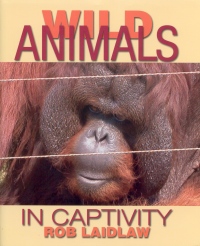| ________________
CM . . .
. Volume XIV Number 21. . . .June 13, 2008 
 |
Wild Animals in Captivity.
Rob Laidlaw.
Markham, ON: Fitzhenry & Whiteside, 2008.
48 pp., hardcover, $21.95.
ISBN 978-1-55455-025-8.
Subject Headings:
Captive wild animals-Juvenile literature.
Animal welfare-Juvenile literature.
Grades 4-7 / Ages 7-12.
Review by Marilynne V. Black.
**** /4
Reviewed from f&g's.
|
| |
|

excerpt:
What does living in captivity mean? For fish, birds, dolphins, gorillas, and other wild animals living in zoos, it means a life that is completely dependent on people. Zoo owners, zoo directors, and zookeepers decide what kind of exhibit the animals live in; how deep they can swim, how high they can fly, or how far they can walk; what and when they eat; which companions or mates they have. Decisions are often based on how much space zoos have and which species attract the most visitors - not on the animals' needs. When that happens, wild animals suffer from living in captivity. For a better life, they require the kinds of natural and complex experiences all animals encounter in the wild.
Laidlaw says that, from an early age, he has identified with the plight of wild animals living in barren and unstimulating zoos. In Wild Animals in Captivity, his eloquent writing enlightens children without being didactic. The technique of juxtaposing how a particular animal lives in a zoo with how it would spend a day in a natural setting is very informative. For example, he contrasts the life of a polar bear in an Indonesian zoo with that of one living in the Arctic. Laidlaw describes the lone polar bear patiently stalking and catching a seal in the cold north. In captivity, the bear, with green algae dyed fur, paces back and forth seeking relief from the heat. Readers can make up their own minds as to which environment is the most beneficial.
The two page "Introduction" outlines Laidlaw's interest in wildlife from his childhood memories of visits to zoos to his present position as director of Zoocheck Canada. He states: "I visit all sorts of zoos. Part of my job is to convince governments to pass better laws to regulate zoos and improve the lives of captive wild animals. Another part involves challenging out-dated and cruel zoo practices and the keeping of wildlife in captivity."
The four chapters are: Living in Captivity, Challenging Animals, Around the Zoo World, and An Elephant Step in the Right Direction. In Chapter 1, Living in Captivity, there are a number of sections: Two Brown Lizards, Captive Lives, Acting Naturally and Unnatural Behavior, Room to Roam, Places to Hide, Something to Do, and Five Freedoms. Sidebars include such topics as Animal Furniture. In other chapters, sidebars give details about the home, size, adaptations, family life and conversation status of various animals under Natural Facts. Included are polar bears, Asian elephants, orcas, and gorillas. Other sidebars detail information about arthritis and foot rot, conditions common to elephants in captivity, the capturing of orcas, and an explanation of the difference between wildlife sanctuaries and conservation centres.
The book is well-designed. Text and captioned pictures of varying sizes are placed attractively on pages with sufficient white space. Chapter numbers and names are rendered in attractive colours while the headings and subheadings are black. In addition, the print size and format add to the uncluttered appearance making it appealing to young readers. Laidlaw also includes a list of 10 ways to help wild animals in captivity. Furthermore, the inclusion of a list of Animal Welfare Organizations, Glossary, and Index extend the usefulness of the book.
Wild Animals in Captivity is a well designed, thorough, yet concise depiction of life for animals in captivity. Laidlaw's balanced presentation not only focuses on examples of inhumane treatment of animals in zoos but also gives instances of the best. He concludes:
Captive wild animals should live in as large a space as possible, with lots of room to explore and act naturally, soft soil under their feet, and private places to escape from people and other animals. But they need much more. If any of their physical or behavioral needs are not met, they may be suffering and need our help.
He then asks the key question: "Should these animals be here at all?"
Wild Animals in Captivity will most certainly assist children in looking more thoughtfully at the zoos they visit.
Highly Recommended.
Marilynne V. Black is a former B.C. elementary teacher-librarian who completed her Master of Arts in Children's Literature (UBC) in the spring of 2005. She is now working as an independent children's literature consultant with a web site at www.heartofthestory.ca.

To comment
on this title or this review, send mail to cm@umanitoba.ca.
Copyright © the Manitoba Library Association. Reproduction for personal
use is permitted only if this copyright notice is maintained. Any
other reproduction is prohibited without permission.
NEXT REVIEW |
TABLE OF CONTENTS FOR THIS ISSUE
- June 13, 2008.
AUTHORS |
TITLES |
MEDIA REVIEWS |
PROFILES |
BACK ISSUES |
SEARCH |
CMARCHIVE |
HOME |
